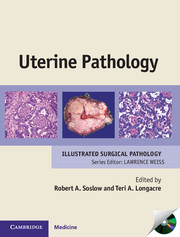Book contents
- Frontmatter
- Contents
- List of contributors
- Preface
- Acknowledgments
- 1 Cytology of the uterine cervix and corpus
- 2 Cervix: squamous cell carcinoma and precursors
- 3 Cervix: adenocarcinoma and precursors, including variants
- 4 Miscellaneous cervical abnormalities
- 5 Non-neoplastic endometrium
- 6 Endometrial carcinoma precursors: hyperplasia and endometrial intraepithelial neoplasia
- 7 Endometrioid adenocarcinoma
- 8 Serous adenocarcinoma
- 9 Clear cell adenocarcinoma and other uterine corpus carcinomas, including unusual variants
- 10 Carcinosarcoma
- 11 Adenofibroma and adenosarcoma
- 12 Uterine smooth muscle tumors
- 13 Endometrial stromal tumors
- 14 Other uterine mesenchymal tumors
- 15 Miscellaneous primary uterine tumors
- 16 Uterine metastases: cervix and corpus
- 17 Gestational trophoblastic disease
- 18 Other pregnancy-related abnormalities
- 19 Lynch syndrome (hereditary non-polyposis colorectal cancer syndrome)
- 20 Cytology of peritoneum and abdominal washings
- Index
- References
12 - Uterine smooth muscle tumors
Published online by Cambridge University Press: 05 July 2013
- Frontmatter
- Contents
- List of contributors
- Preface
- Acknowledgments
- 1 Cytology of the uterine cervix and corpus
- 2 Cervix: squamous cell carcinoma and precursors
- 3 Cervix: adenocarcinoma and precursors, including variants
- 4 Miscellaneous cervical abnormalities
- 5 Non-neoplastic endometrium
- 6 Endometrial carcinoma precursors: hyperplasia and endometrial intraepithelial neoplasia
- 7 Endometrioid adenocarcinoma
- 8 Serous adenocarcinoma
- 9 Clear cell adenocarcinoma and other uterine corpus carcinomas, including unusual variants
- 10 Carcinosarcoma
- 11 Adenofibroma and adenosarcoma
- 12 Uterine smooth muscle tumors
- 13 Endometrial stromal tumors
- 14 Other uterine mesenchymal tumors
- 15 Miscellaneous primary uterine tumors
- 16 Uterine metastases: cervix and corpus
- 17 Gestational trophoblastic disease
- 18 Other pregnancy-related abnormalities
- 19 Lynch syndrome (hereditary non-polyposis colorectal cancer syndrome)
- 20 Cytology of peritoneum and abdominal washings
- Index
- References
Summary
INTRODUCTION
Uterine leiomyomas are the most common mesenchymal tumor in the female genital tract; the vast majority are easily diagnosed. Most uterine leiomyosarcomas, although much less common, are also readily diagnosed. Diagnostic problems arise when uterine mesenchymal tumors exhibit (1) altered or non-standard forms of smooth muscle differentiation (myxoid, epithelioid, etc.), (2) variant or ambiguous histologic features (e.g., increased cellularity, cytologic atypia, increased mitotic figures, or necrosis), (3) a mixture of smooth muscle and stromal differentiation, or (4) unusual anatomic distribution.
The diagnosis of uterine smooth muscle tumors depends on: the degree of experience with that entity (i.e., uterine leiomyomas are very common and, therefore, histologic criteria are well defined and well recognized for the vast majority of these tumors); the extent to which the specimen under evaluation is representative of the entire tumor (a particular issue with uterine samplings and myomectomy specimens); and the extent to which the tumor exhibits non-ambiguous morphologic or anatomical distributional features. Uterine smooth muscle tumors that are rarely encountered and therefore have less reported clinical follow-up data are often more correctly referred to as “with limited experience,” while those that defy classification using standard criteria are more appropriately labeled as “uncertain malignant potential.” Most uterine tumors of “uncertain malignant potential” may prove, over time and accumulated experience, to have low recurring potential (recurrences to local pelvic or intra-abdominal sites) or low malignant potential (delayed metastases to lung, bone, etc., with prolonged clinical course following excision of the metastases – i.e.
- Type
- Chapter
- Information
- Uterine Pathology , pp. 219 - 250Publisher: Cambridge University PressPrint publication year: 2012



